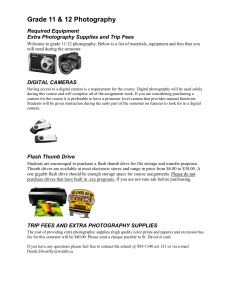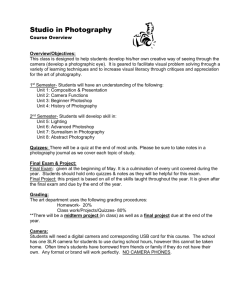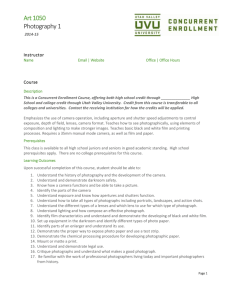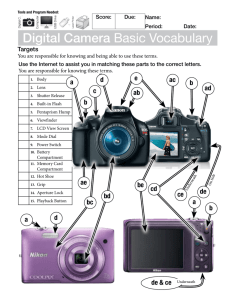E C XPERIMENTAL
advertisement
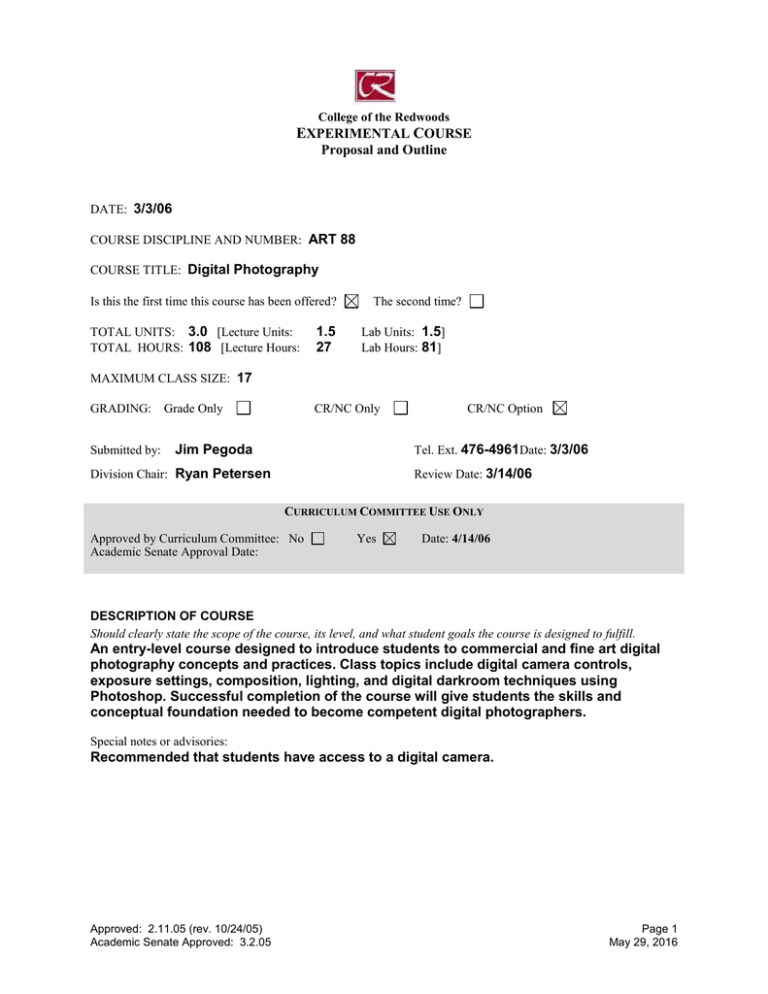
College of the Redwoods EXPERIMENTAL COURSE Proposal and Outline DATE: 3/3/06 COURSE DISCIPLINE AND NUMBER: ART 88 COURSE TITLE: Digital Photography Is this the first time this course has been offered? TOTAL UNITS: 3.0 [Lecture Units: TOTAL HOURS: 108 [Lecture Hours: 1.5 27 The second time? Lab Units: 1.5] Lab Hours: 81] MAXIMUM CLASS SIZE: 17 GRADING: Submitted by: Grade Only CR/NC Only Jim Pegoda CR/NC Option Tel. Ext. 476-4961Date: 3/3/06 Division Chair: Ryan Petersen Review Date: 3/14/06 CURRICULUM COMMITTEE USE ONLY Approved by Curriculum Committee: No Academic Senate Approval Date: Yes Date: 4/14/06 DESCRIPTION OF COURSE Should clearly state the scope of the course, its level, and what student goals the course is designed to fulfill. An entry-level course designed to introduce students to commercial and fine art digital photography concepts and practices. Class topics include digital camera controls, exposure settings, composition, lighting, and digital darkroom techniques using Photoshop. Successful completion of the course will give students the skills and conceptual foundation needed to become competent digital photographers. Special notes or advisories: Recommended that students have access to a digital camera. Approved: 2.11.05 (rev. 10/24/05) Academic Senate Approved: 3.2.05 Page 1 May 29, 2016 COURSE LEARNING OUTCOMES What should students be able to do as a result of taking this course? State some of the objectives in terms of specific, measurable student accomplishments. On successful completion of this course students will be able to do the following: 1. Use the control settings on a digital camera to affect the image quality, storage capacity, and shooting performance of their digital camera. 2. Use basic camera exposure concepts to obtain correct exposure and creative control in a variety of shooting situations. 3. Create dynamic imagery using the process of visual selection and design priciples that relate to photography. 4. Edit and enhance digitally captured imagery using current digital darkroom techniques. 5. Print digital photographs using color management and current photo inkjet printing technology. COURSE CONTENT Attach a copy of the course syllabus (including description, policies, and schedule of instruction and assignments). See Attached Syllabus. REPRESENTATIVE LEARNING ACTIVITIES What will students be doing (e.g., listening to lectures, participating in discussions and/or group activities, attending a field trip)? Relate the activities directly to the Course Learning Outcomes. Learning activities will include the following: 1. Lectures designed to explain and demonstrate digital camera controls, exposure concepts, lighting, composition and digital darkroom techniques. 2. Reading assignments that reinforce the content of lecture. 3. Quizzes based on reading assignments and lecture material. 4. Guided skill-building exercises that give students hands-on experience using a digital camera, processing digital photographs with image editing software, and printing. 5. Major projects requiring students to use a digital camera to capture and process imagery based on the specific parameters described in project handouts. 6. Class critiques, which play a role in the development of students' visual vocabulary and aesthetic sensitivity. ASSESSMENT TASKS How will students show evidence of achieving the Course Learning Outcomes? 1. Students will engage in a series of skill-building exercises based on lecture and demonstrations. Upon completion of each assignment the students will receive feedback and evaluation from the instructor on the quality and completeness of each exercise. 2. Each set of skill-building exercises is intended to give students the skills and conceptual foundation needed to complete each of the major projects. 3. Upon successful completion of the major projects, students will have demonstrated their ability to utilize the full spectrum of skills and concepts covered in the course. The quality and completeness of work generated by students for major projects will be measured by assessing how well the work meets the goals outlined in the project handouts and rubric. Approved: 2.11.05 (rev. 10/24/05) Academic Senate Approved: 3.2.05 Page 2 May 29, 2016 PREREQUISITES No Yes Course: Rationale for Prerequisite? Describe representative skills without which the student would be highly unlikely to succeed. COREQUISITES No Yes Rationale for Corequisite: Course: RECOMMENDED PREPARATION No Yes Course: Rationale for Recommended Preparation: EXAMPLES OF APPROPRIATE TEXTS OR OTHER READINGS: Title, Author, and Date are required. Author Ben Long Title Complete Digital Photography Date 10-04 Author Bryon Peterson Title Understanding Digital Photography Date 10-05 Author Jay Dickman and Jay Kinghorn Title Perfect Digital Photography Date 10-05 Author Jim Miotke Title The Better Photo Guide To Digital Photography Date 10-05 Other Appropriate Readings: Ben Willmore, Adobe Photoshop CS2 Studio Techniques, 8-05 Approved: 2.11.05 (rev. 10/24/05) Academic Senate Approved: 3.2.05 Page 3 May 29, 2016 FOR VPAA USE ONLY PROGRAM AND COURSE NUMBER ART-88 TECHNICAL INFORMATION 1. Department: ARTS Arts 2. Subject: ART 16. CoRequisite Course: none Course No: 88 17. CoRequisite Noncourse: none 3. Credit Type: D Credit Degree Applicable 18. Maximum Class Size: 17 4. Min/Maximum Units: 3.0 to 19. Repeat/Retake: Choose One: variable units 5. Course Level: E Not Occupational 20. Count Retakes for Credit: yes no 6. Academic Level: UG Undergraduate 21. Only Pass/No Pass: yes no 7. Grade Scheme: UG Undergraduate 22. Allow Pass/No Pass: yes no 8. Short Title: Digital Photography 23. VATEA Funded Course: yes no 9. Long Title: Digital Photography 24. Accounting Method: W Weekly Census 10. National ID (CIP): 50.0101 25. Disability Status: N Not a Special Class 11. Local ID (TOPS): 100100 26. Billing Method: T-Term 12. Course Types: Level One Basic Skills: NBS Not Basic Skills 27. Billing Period: R-Reporting Term 28. Billing Credits: 3.0 Level Two Work Experience: NWE Not Coop Work Experience 29. Purpose: A Liberal Arts Sciences Level Three: 30. Articulation No. (CAN): Placeholder for GE OR DOES NOT APPLY 31. Articulation Seq. (CAN): Level Four: If GE : Choose One: 32. Transfer Status: B Transfers to CSU only 13. Instructional Method: LL Lecture/Lab 14. Inst Ld (TLUs): 6.75 33. Equates to another course? course number. Contact Hours: 108.0 15. Prerequisite: none Particular Comments for Printed Schedule. Recommended that students have access to a digital camera.. Approved: 2.11.05 (rev. 10/24/05) Academic Senate Approved: 3.2.05 Page 4 May 29, 2016



